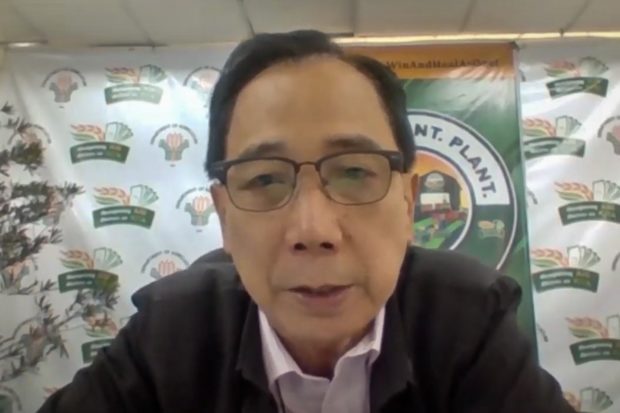
Agriculture Secretary William Dar. (File photo from a video by the Senate Public Relations and Information Bureau)
MANILA, Philippines — Agriculture Secretary William Dar denied on Monday the allegation that the proposal of his department to lower the tariff rates on imported pork and increase its volume was based on “exaggerated” projections.
“We want to share with you our computation for the MAV [minimum access volume] — plus so that everyone will have a better appreciation. This is not OA [overacting],” Dar said in Filipino during a House hearing jointly conducted by agriculture and trade committees.
Filipinos sometimes use “OA” to mean “exaggerated.”
President Rodrigo Duterte recently endorsed to Congress the DA recommendation to temporarily increase the MAV for pork imports by 350,000 metric tons on top of the current 54,210 MT — or a total of over 404,000 MT.
Bureau of Animal Industry (BAI) Director Reildrin Morales, who cited data from the Philippine Statistics Authority, explained to House lawmakers that the country’s swine inventory was seen to have been reduced to over 9.7 million hogs in 2021 from the 12.7 million in 2020 — or a decrease of 24 percent of over 3 million pigs.
The 9.7 million pigs projected for 2021 equates to 1.2 million metric tons (MT). The projected pork demand this year is 1.6 million MT, which means there’s a supply deficit of around 400,000 MT.
The demand is based on a per capita consumption of 15 kilograms.
Before the DA officials explained the basis for their recommendation, Marikina Rep. Stella Quimbo, who is an economist, said only 175,000 MT would be needed to fill the shortage of 400,000 MT.
Citing records at the Bureau of Customs, she said the total pork imports in 2020 added to the current MAV of 54,210 MT already reached a total of 225,000 MT.
“Why did it come to this OA projection of proposing that our MAV be increased to 404,000 MT?” Quimbo asked in Filipino.
“The fact that the 54,000 MAV has the capacity to bring in imports of 225,000 metric tons [means] the gap we need to fill is only 175,000 metric tons. So the increase of 350,000 metric tons is really very OA,” she added.
Further, she questioned the lowered tariff rates on pork imports.
Upon the recommendation of the Department of Agriculture, the President signed Executive Order No. 128, which temporarily lowers tariff rates on fresh, chilled, or frozen pork meat “to address the existing pork supply shortage, stabilize prices of pork meat, and minimize inflation rates.”
Under that order, the tariff rate on pork imports under quota — that is, below the MAV — is reduced to 5 percent from 30 percent for the first three months of the validity of the order. It also reduces the tariff rate on pork imports above the MAV to 15 percent from 40 percent in the first three months of its effectivity.
After 12 months since the effectivity of the order, the tariff rate will be reverted to the current rate of 30 percent for in-quota imports and 40 percent for out-quota imports.
“I think lowering the tariff rate to 5 percent is also exaggerated… Based on my computation, we need not lower the tariff to this level. In fact, lowering it to only 25 percent will already work for that purpose,” Quimbo said, referring to the need to fill in the country’s pork supply deficit for 2021.
However, Undersecretary Mercedita Sombilla of the National Economic and Development Authority (NEDA) said lowering the tariff to only 25 percent would not reduce pork prices.
“If we’re just going to be within that bandwidth that you’re saying, to bring it really down to around P224 per kilogram, it has to be between 5 percent to probably 15 percent,” Sombillo said.